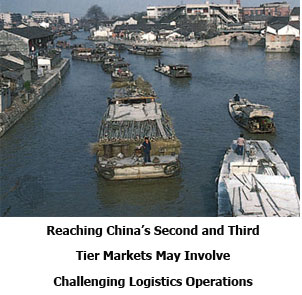(Global Supply Chain and Logistics Article - Continued)
As Procter & Gamble is already doing in developing across the world, that will mean crafting a very different supply chain capable of physically delivering products effectively to these more remote markets – and at a cost to make and deliver at even lower levels than is required for the first tier cities. It may mean changing product production specifications and packaging to support cost targets and logistics requirements.
Western companies often fail to appreciate the differences within major regions of China, Tse says. Just a short distance from a burgeoning urban center may be large areas that are mostly rural and undeveloped – but which Western companies may need to serve to meet growth targets. A supply chain may need to be crafted that can serve both.
 Preparing for Flexibility and Change Preparing for Flexibility and Change
In a market as diverse and dynamic as China’s, supply chain flexibility is also essential for success. A product category that has had little market success can suddenly explode, as income and interests change – meaning companies capable of rapid response to this new demand spike can gain long term-competitive advantage.
Tse notes that until just a decade ago, most milk outside the largest cities was consumed in powdered form, as production and distribution systems could not get regular milk safely to consumers.
But as the supply chain solved that problem, Chinese milk demand exploded – allowing a few companies to profit handsomely and continue to enjoy high growth rates. Cell phone growth rates have recently exceeded even the rapid curves seen as the industry developed in Western economies. Companies must have supply chains capable of reacting to these kinds of opportunities with extreme speed.
Understanding the Regulatory Environment
“We’ve found that too few business leaders really understand the regulatory context, and even fewer understand how it’s likely to change in the future,” Tse notes. “Although some outsiders may perceive that Beijing makes it very difficult for foreign companies to break into the Chinese market, the truth is that for the last 15 years, China has been quite progressive.”
He says that in many respects, China is even now more open than say Korea and Japan to foreign competitors, and that the Chinese government is opening up its industries to more foreign participation, sector by sector, especially in consumer goods.
At the same time, China’s regulations regarding a wide range of business practices, especially in such areas as the environment, are also changing rapidly, both nationally and in specific regions.
In total, making investments in understanding the regulatory environment and future in China is key to lasting success there.
Multi-Faceted Approach – and Multiple Supply Chains
These and other factors mean most companies need to develop a diverse approach to operating in China.
It’s pretty well understood by now that a company can’t simply transplant its existing business processes there. But there is also not one China-focused approach either – the successful approach can vary significantly by product market, depending on the size and maturity of the category, level of domestic Chinese competitors, distribution requirements, and other factors.
Tse said company and supply chain execs need to take a “helicopter view” of opportunities and changes in China – looking consistently at the landscape and patterns of change.
The implications for the supply chain are also clear – even more so than in Western markets, companies must craft different supply chains to meet the needs of groups of individual product-markets. This complicates the opportunities for standardization of business processes and use of scale and leverage, yet ultimately may be among the greatest keys to success in China’s huge market.
Do you agree with this perspective on having success in China’s domestic market? How important is the supply chain there? Do you need to craft multiple supply chains based on product-markets? Let us know your thoughts at the Feedback button below. |